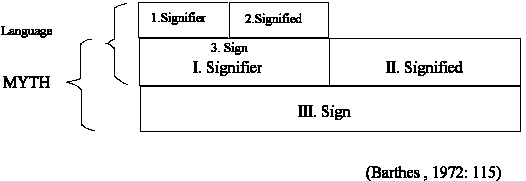
(Barthes, 1972: 115)

(Apologies for the quality of some of the graphics)
A while ago now I, as part of a panel, was asked by a publisher of curriculum materials to review and comment on the three series of school mathematics textbooks they published. The three series were distributed to three different markets defined along the lines of race at the time: House of Assembly schools ('white'), House of Representative schools ('coloured'), and Department of Education and Training schools ('african'). The publisher hoped to use the review as an initial step towards rewriting the textbooks to meet the demands of the immanent changes in the organisation of state-funded education in South Africa.
The textbook series destined for the Department of Education and Training schools was obviously different from the others: it was heavily didactic, showing many examples of how students were to perform various calculations, and it presented the exposition in a form which resonated with that of comic books and cartoons. It seemed that the publisher was using jelly-bean type characters interacting in a cartoon-like format to deal with the problem of the making mathematics relevant to the lives of school children as well as the problem of achieving politically correct gender and racial representations in the textbooks: the characters, who are always having fun, are apparently neutral with respect to gender and ethnicity—generic school children, pure subjects of mathematics emptied of all socio-cultural specificities. A neat solution in politically volatile South Africa.
In my reading of the textbook series, however, it became increasingly difficult to accept and sustain the apparent socio-cultural neutrality of the books. In fact, the world of the textbook seemed to be congruent with the world outside of the classroom rather than a disruption of that world. Can this congruence be described in semiotic terms? Specifically, for the purpose of this paper, how is it that high ability is distributed to males and low ability to females in the textbooks?
I draw on the work of Barthes, Dowling and Eco to discuss the assigning of mathematical ability and competence to male and female primary school students through the use of icons in one of the primary school textbooks—Understanding Mathematics 5—published by Maskew Miller Longman in South Africa. Alongside a close reading of iconic text I shall also produce a content analysis which will reveal the degree of visibility of males and females in the text as a whole. This particular textbook is similar to all the others in the series and is the textbook used in the final year at primary school.
Signs as representations of people and things in writing and images always signify more than that which they apparently denote. Through the workings of intertext a second order of signification is produced: that which is connoted. Barthes (1972) refers to this second order signification as 'myth':

(Barthes, 1972: 115)
I shall use Barthes' definition of the mythical to point to the production of myth in the text which I analyse. I shall also use Eco's (1979) formulation of the relationship between metaphor and metonymy: metaphors can be established by metonymic substitution (Dowling, 1993, 72) since the poles of the metaphor can be linked by a sequence of subjacent metonyms:
A metaphor can be invented because language, in its process of unlimited semiosis, constitutes a multidimensional network of metonymies, each of which is explained by a cultural convention rather than by an original resemblance. The imagination would be incapable of inventing (or recognizing) a metaphor if culture, under a form of the possible structure of the Global Semantic System, did not provide it with the subjacent network of arbitrarily stipulated contiguities. The imagination is nothing other than a ratiocination that traverses the paths of the semantic labyrinth in a hurry and, in its haste, loses the sense of their rigid structure. The 'creative' imagination can perform such dangerous exercises only because there exist 'Swedish stall-bars' which support it and which suggest movements to it, thanks to their grill of parallel and perpendicular bars. The Swedish stall-bars are Language {langue}. On them plays Speech {parole}, performing the competence. (Eco 1979, 78)
In my reading of Understanding Mathematics 5, the production of the myths of female low ability and male high ability is facilitated by the attaching of metonyms to first order signification by exploiting the echoing of other texts which circulate through the text under discussion.
Understanding Mathematics 5 makes extensive use of representations of children as transmitters of mathematical knowledge. The images, through various devices which will be discussed below, are metonymically attached the student readers of Understanding Mathematics 5 as well as to cartoons in general.
On page two of Understanding Mathematics 5 (see Plate 1) the reader is presented with a classroom scene: creatures that are somewhat similar to humans, show humanoid facial features (with the exception of ears), speak English, and are arranged in rows of desks. Through a simplified use of perspective and three posters (or wall charts) a wall is suggested behind the creatures. The creatures are participating in various activities: sleeping, shooting pellets through what looks like a pea shooter, puzzling over some or other idea or question, raising their arms, perhaps wanting to respond to a question or tell on a mate, passing a note around, and, in the far corner, almost hidden from view but for the wearing of a conical hat displaying a "D", sits (what must be) the class dunce. Sometime later in the book names (John, Cindy, Allison, Jabu, etc.) are attached to the creatures. The scene therefore signifies a teacher and her/his students in a classroom. The teacher is denoted by the presence of a mortar-board.
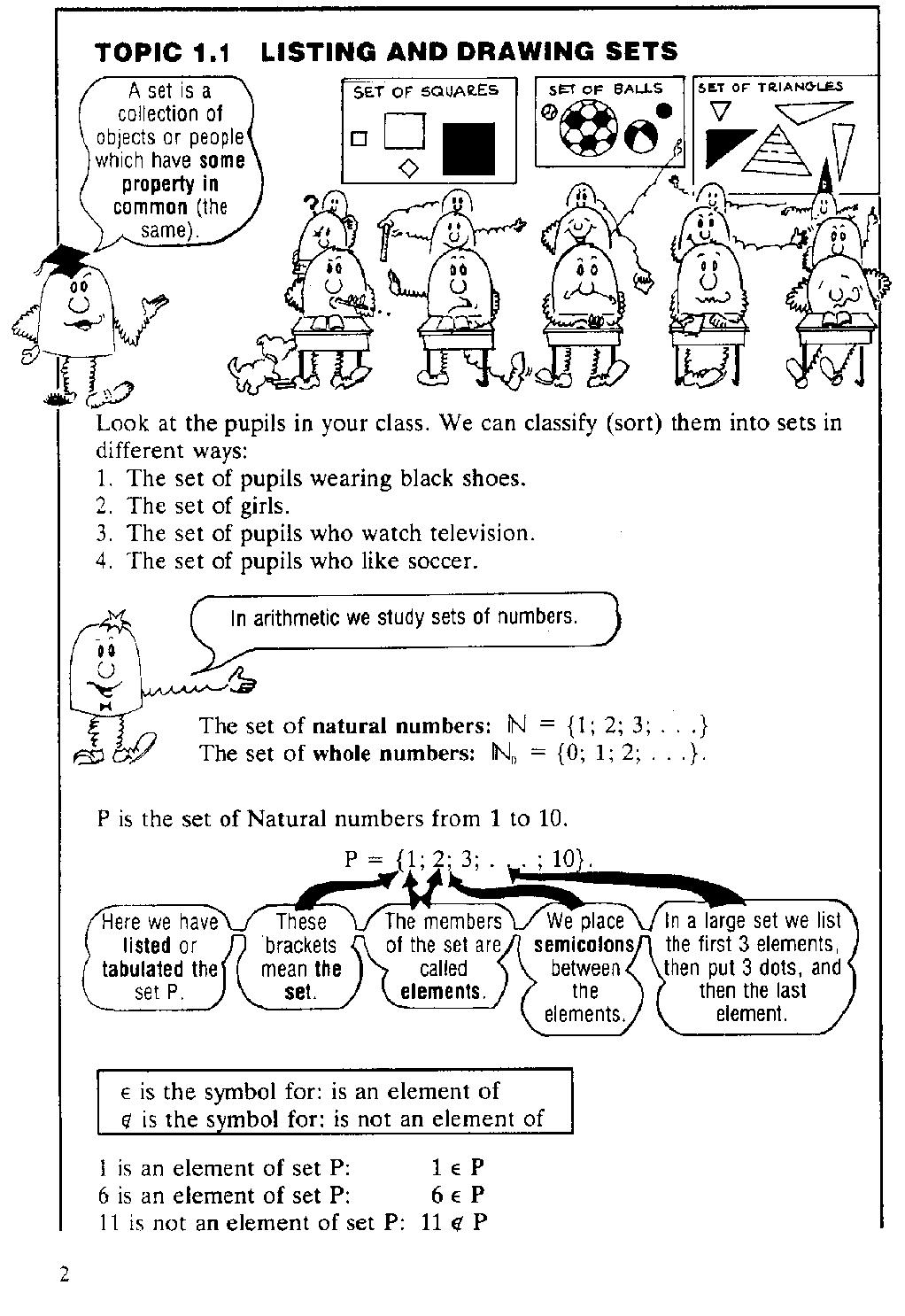
The use of simplified perspective, compression of detail and an unrealistic style (suggestions rather than accurate depictions of people and things) connotes children's comic books (Hodge & Kress, 1988, 121 ff.). This connotation is strengthened through the use of speech- and thought-bubbles to display utterances and thought of the teacher and students. The cover of the textbook shows five smiling children running along and waiving drawing instruments. Whether they are running towards or away from the mathematics classroom remains uncertain for there is a suggestion of fun and play in their activity; it is much easier to associate child play and recreation with comics and cartoons than with mathematics.
Peirce differentiates between different types of signs in his Collected Papers: icons, indices and symbols (Silverman, 1983, 19). As my chief interest in this paper is the use of iconic text in Understanding Mathematics 5, I shall not pay much attention to indices and symbols as described in Peirce. For Peirce the iconic sign partially resembles its referent, possibly sharing properties with it or duplicating the organising principles which the referent is subject to:
Those which partake of simple qualities ... are images; those which represent the relations, mainly dyadic, or so regarded, of the parts of one thing by analogous relations in their own parts, are diagrams ... (Peirce in Silverman 1983: 19)
Examples of icons in Peirce's scheme are images of various kinds¾sculptures, paintings, cinematic images, cartoons, diagrams¾as well as graphs and mathematical equations. However, for my purposes, I must adapt Peirce's notion of the iconic.
Since I wish to examine the use of these cartoon-like representations in Understanding Mathematics 5 I will exclude graphs, mathematical equations and symbols from the iconic, except where they are accompanied by cartoon-like representations (I shall refer to the representations as cartoon figures).
Plate 2 shows an example of a typical page which contains iconic text. The cartoon figures speak through speech bubbles, explaining their playing of a game on an "adding board". Following this¾and not in speech bubbles¾a number of variations on the game are listed after which addition on a number line is illustrated. Even though these latter bits of text are not directly linked to the cartoon figures, I want to argue that it is read as a continuation of the speech of the cartoon figures and that this is the case in general.
With every occurrence of the transmission of mathematical knowledge in Understanding Mathematics 5, as opposed to the listing of mathematical tasks (exercises/problems), such transmission is accompanied by cartoon figures and is enclosed in a rectangular box which punctuates it off from the rest of the text on the page. Plate 1, the first page of Understanding Mathematics 5 which attempts the transmission of mathematical knowledge, shows the teacher introducing a class (as a collection of sets). Halfway down the page a cartoon figure, representing someone other than the teacher, takes over the teaching which is subsequently taken over by a different character. Plate 1 exhibits the only representation of a cartoon figure which unambiguously denotes a teacher in Understanding Mathematics 5. From this point on the teacher is banished from the text and the teaching of mathematics is left to students.
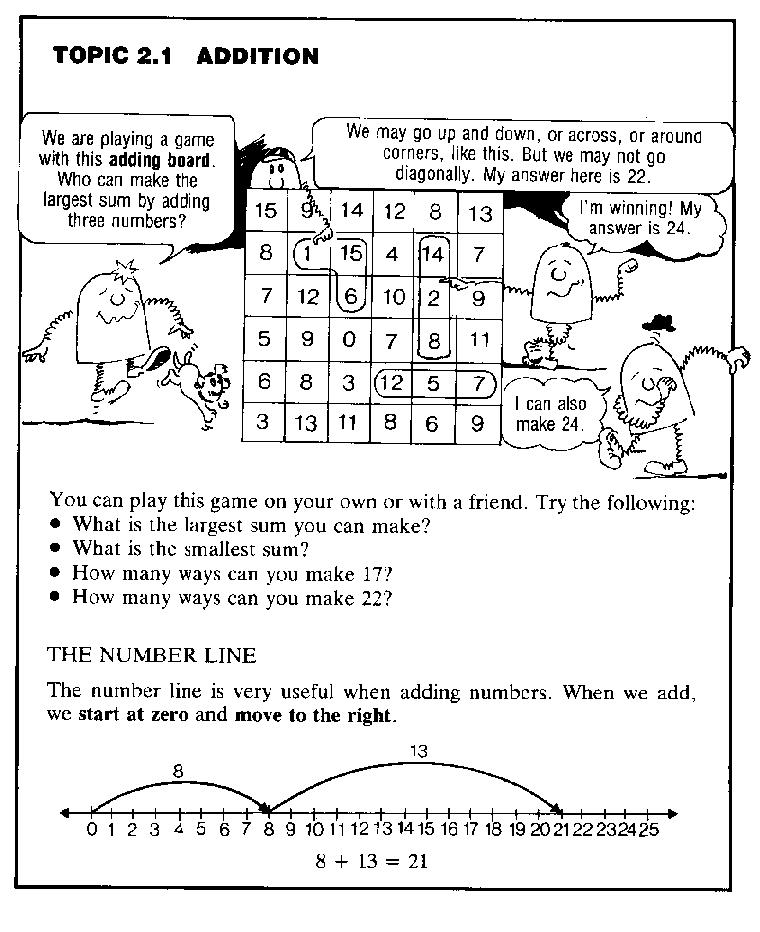
The extent to which the reader identifies with the depicted scenes and characters is dependent on 'modality'¾the kind of truth value attached to them (Hodge & Kress, 1988, 26):
Modality is ... in play at all times, in every semiotic act. The affirmation of 'security' over the system of classification is an instance of the operation of modality, as much as the assertion of its 'insecurity'. Consequently all utterances (to use a verbal analogy) are modalized. What does vary is the use of modality either to affirm the 'security' of the classification system asserting its 'truth' or its status as 'reality', or to bring the security of the system into question, challenging its status as 'truth' or as 'reality': calling it 'fiction' rather than 'fact', for instance. Given that what is at issue is the question of 'affinity' or lack of affinity of the participants with the system (and thereby with each other) we can speak of a modality of high affinity ... or of low affinity (with the system) ... (Hodge & Kress 1988: 123; my emphasis)
Although having no empirical evidence in support, I conjecture that the features of the text discussed above establish a relation of high affinity of students with the text. For the student reader it would therefore become increasingly difficult to associate explanations and instructions which are not in speech bubbles with the teacher; such text signifies instead the utterances of already mathematically competent student-pedagogues. In this analysis, therefore, cartoon figures as well as typescript, diagrams and graphs associated with the cartoon figures, all enclosed in a box, constitute one category of icon (Type 1).
A second category of icon (Type 2) is constituted by cartoon figures which appear alongside mathematical tasks (see Plate 2). These cartoon figures and the tasks are not boxed and the figures are not transmitting mathematical knowledge. Rather, they are shown as participating in various types of physical exercise or recreation. The mathematical tasks are not read as part of the iconic text.
Words, symbols and images in Understanding Mathematics 5 occupy a rectangular area of 20cm by 14cm. In order to measure the proportion of area occupied by icons I constructed a 20cm by 14cm grid on an acetate sheet which I then superimposed on each page. The individual 1cm by 1cm squares covering iconic and non-iconic text were counted for each page in every chapter of the book. The proportion of iconic text per chapter was expressed as a percentage of the total text comprising that chapter; the results are shown in Table 1. Over the whole book 67,6% of textual space is devoted to iconic text.
With such a heavy proportion of iconic text through which students are presented as teachers in Understanding Mathematics 5 one is tempted to ask how and if metonymic links to race, gender and class are attached to students with respect to mathematical competence. Which students are selected as mathematically competent? Given limited space I have chosen to focus only on gender.
| Chapter # | Topic | No. of pages | Proportion (%) |
| 1 | Sets |
8 | 89,5 |
| 2 | Natural & whole numbers |
36 | 56,8 |
| 3 | Geometry |
13 | 66,5 |
| 4 | Common fractions |
43 | 73,5 |
| 5 | Number sentences |
6 | 65,6 |
| 6 | Working with geometrical figures |
27 | 74,8 |
| 7 | Working with decimal fractions |
34 | 53,6 |
| 8 | Percentage |
12 | 59 |
| 9a | Volume |
6 | 54 |
| 9b | General revision |
5 | 0 |
Initially it is not clear how gender is signified in Understanding Mathematics 5. However, at various places in the text names are attached to cartoon figures. I have collected a number of such occurrences in Plate 3.
It becomes clear from an analysis of the images that dress plays a central role in assigning gender to the figures. With regard to dress it is only the absence of head dress or the presence of a peak cap or bow tie that signifies the masculine. The feminine is signified by a hair bow or a chef's cap; females always wear some form of head dress. This signification of the feminine is emphasised by showing girls participating in stereotypical female activities: Thandi and Thembi weigh themselves; Alison bakes a cake. Boys are never shown participating in such activities. This analysis enables the identification of representations of boys and girls in iconic text.
It would hardly be surprising if an analysis showed that male students were privileged above females; the social is already organised along lines of gender differentiation and preference with respect to various activities. A quantitative content analysis clearly suggests that Understanding Mathematics 5 selects boys rather than girls as already competent student-pedagogues: I counted the number of occurrences of boys and girls teaching (in Type 1 icons) and found that boys teach most of the time, animals (dogs and birds) sometimes teach, and that girls never teach.
| Male teaching | Female teaching | Animal teaching |
| 265 | 0 | 4 |
| 98,5% | 0% | 1,5% |
I also counted the number of occurrences in iconic text (Types 1 and 2) of girls, boys and animals speaking (Table 3) as well as references to males and females in iconic and non-iconic text (Table 4). Both tables suggest that males are much more visible than females in Understanding Mathematics 5.
| Male speech | Female speech | Animal speech |
| 279 | 6 | 13 |
| 93,6% | 2% | 4,4% |
These findings are in general agreement with research on gender bias in textbooks: Cairns & Inglis (1989), Heathcote (1982), Morehead (1984), Nibbelink et al (1986), Northam (1982) and Walkerdine et al (1989). While quantitative content analyses of texts are useful in alerting one to certain features of the text which might go unnoticed, such analyses are not able to adequately describe the textual strategies implicated in, for example, the attaching of different levels (or amounts) of ability and competence to boys and girls.
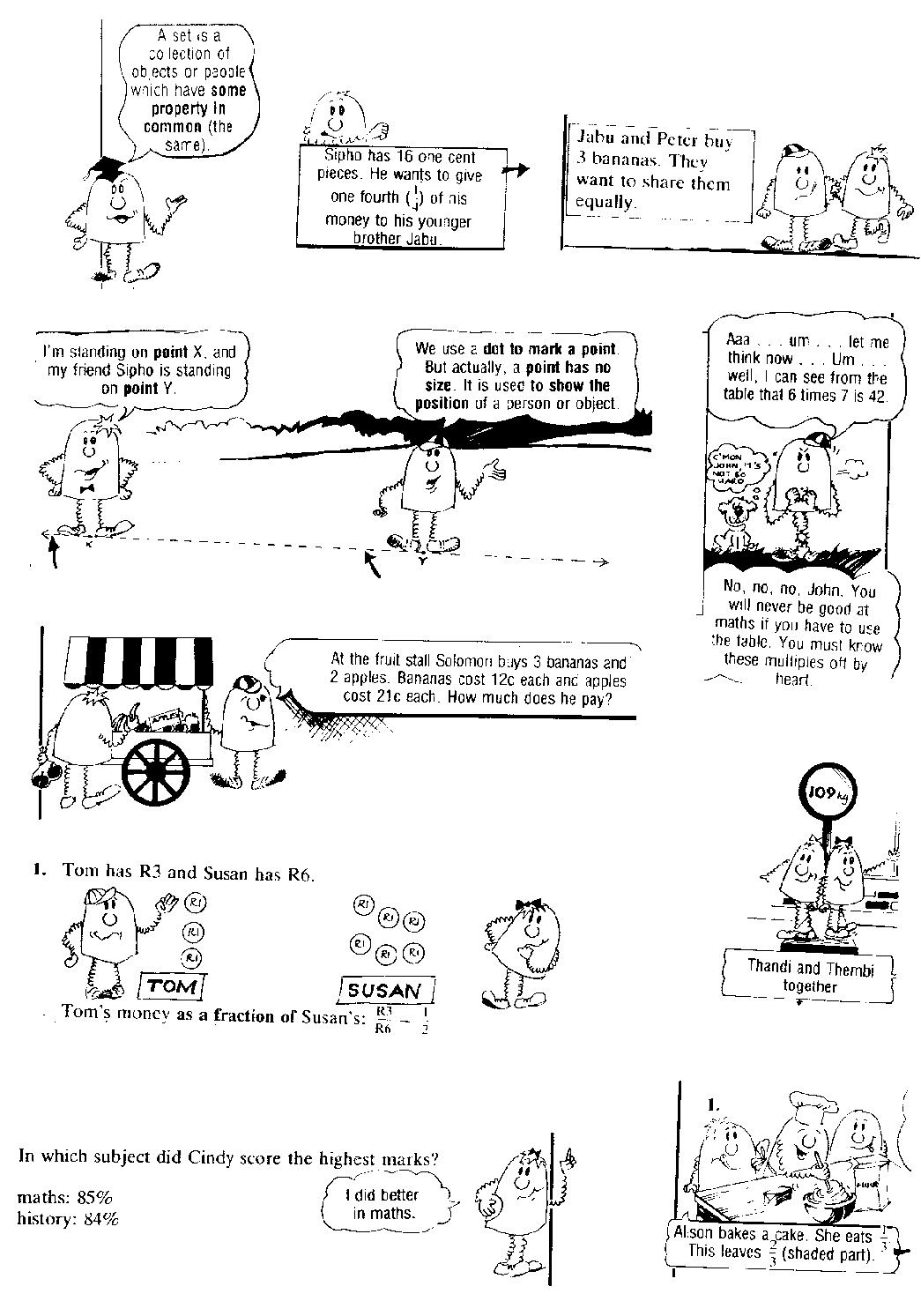
I have already pointed out above that boys and animals are selected as teachers rather than girls. Where females appear in the text they are used to generate mathematical tasks which boys solve, the solutions of which are held up as solution procedures for all students to learn: Plate 4 shows two such instances. Under the topic heading "Dividing large numbers" we see the shopkeeper posing a question to a group of boys, much as a teacher would in a classroom. It is a male student rather than the shopkeeper who provides the exemplary solution. Similarly, under the heading "More multiplication" we see Alison baking a cake. It seems that since Alison is a school student (the boys refer to her by first name), she is unable even to present the task herself. Her activity is mathematised by a male character who then goes to present a solution procedure.
| Males | Females | ||
|
1 |
|
1 |
|
2 |
|
1 |
|
4 |
|
1 |
|
9 |
|
3 |
|
3 |
|
1 |
|
1 |
|
1 |
|
7 |
|
1 |
|
18 |
|
1 |
|
1 |
|
2 |
|
3 |
|
1 |
|
1 |
|
1 |
|
1 |
|
1 |
|
1 |
| 1 |
|
1 |
|
1 |
|
9 |
|
1 |
|
1 |
|
15 |
|
1 |
|
3 |
|
2 |
|
10 |
|
2 | ||
|
1 | ||
|
3 | ||
|
1 | ||
|
1 | ||
|
3 | ||
|
1 | ||
| Total | 78 | Total | 46 |
| 62,9% | 37,1% | ||
Under the topic "Using percentage to compare quantities" (not shown) we see Cindy stating that she scored 17 out of 20 on a mathematics test and 21 out of 25 on a history test. This is all that Cindy does. The scores are converted to percentages for her and displayed. Cindy concludes that she did better at mathematics than history. The fact that Cindy scores 85% on a mathematics test still does not enable her to do the calculations! It is not that she lacks the ability to do the calculation, but rather that it is unacceptable, within Understanding Mathematics 5, to have her teach mathematics.
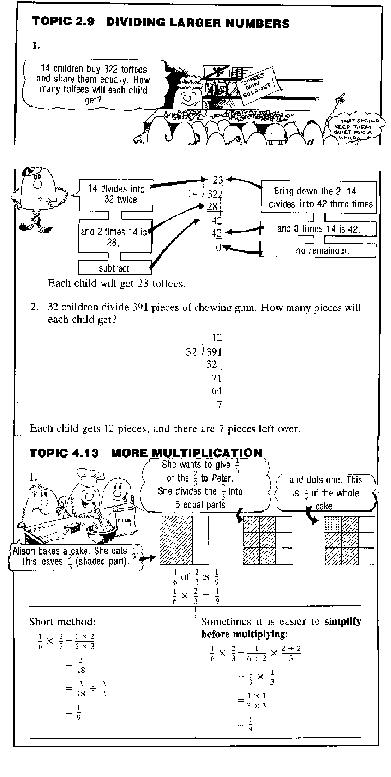
Females are also never shown doing mathematics. When they are shown alongside calculations they are involved in non-mathematical activity: weighing themselves, baking cakes, selling sweets, buying sweets, window shopping and reporting on test scores. Boys are involved in mathematical activity most of the time. They are shown doing things like, for example, comparing the efficiency of various multiplication procedures and gazing out on the world and mathematising everything in sight.
Through its exploitation of the strategies highlighted above, the text is implicated in the production of a mythical system which produces male readers as more competent and able mathematicians than female readers: the text does not merely signify that all students are competent autodidacts but, crucially, selects them along gender lines from the pool of readers.
I will now focus briefly on the use of Type 2 icons.
Plate 5 shows a sample of typical Type 2 icons. Most of the exercises in Understanding Mathematics 5 are accompanied by cartoon figures involved in some form of physical exercise or recreation. The activities presented are never mathematical, but are instead a juxtaposition of mathematical exercises and physical exercise to produce a series of puns. The result is an ironic comment on the students' apparent interest in mathematics. Through the Type 2 icons the movement in the text around the exercises is away from mathematics and towards the recreational. The myth of (male) students being always already competent student-pedagogues and autodidacts undoes itself and all is restored to normal; teachers need not worry.
Gender associations with the exercises is largely limited to the masculine. One finds that only one Type 2 icon includes a female on page 115 of Taylor & Myburgh. As with Type 1 icons, males and animals enjoy far more visibility than females in Type 2 icons (see Table 5).
| Male | Female | Animal |
| 33 | 1 | 6 |
| 82,5% | 2,5% | 15% |
Table 5 Understanding Mathematics 5: Fun associations with mathematical tasks (exercises/problems)
One finds, then, in Understanding Mathematics 5, despite the use of cartoon figures that exhibit on first reading an apparent gender neutrality, that various textual strategies are employed to distribute mathematical ability differentially to male and female readers. The dominant textual learner which emerges from this reading of the text is a male autodidact. Where the feminine does appear it is almost always subordinated to the masculine and is used as a resource to facilitate male mathematising of the social: the dominant voice of school mathematics is masculine and its subordinate voice is female. The text, through the puns it constructs around the sets of exercises (Type 2 icons), might well deconstruct its construction of the mythical ideal masculine learner.

This analysis of Understanding Mathematics 5 should not be read as implying that the authors deliberately set out the write a gender bias into the text. The fact is that the social already has gender differentiation and bias structured into it. This structuring of the social facilitates both the production of texts like Understanding Mathematics 5 as well various readings of the text, uncritical as well as critical. The difference between the two readings is that the former reads convention as nature while the latter insists that nature is constructed by convention.
Barthes, R. (1972) Mythologies, London: Vintage
Barthes, R. (1981a) "Theory of the Text" in Young, R. (ed.) Untying the Text: a poststructuralist reader, London: Routledge & Kegan Paul
Cairns, J. & Inglis, B. (1989) "A Content Analysis of Ten Popular History Textbooks for Primary Schools with Particular Emphasis on the Role of Women" in Educational Review 41(3), pp. 221-6.
Dowling, P. C. (1991a) "A Touch of Class: ability, social class and intertext in SMP 11-16" in Pimm, D. & Love, E. (eds.) Teaching and Learning School Mathematics, London: Hodder & Stoughton
Dowling, P. C. (1991b) "Gender, Class and Subjectivity in Mathematics: a critique of Humpty Dumpty" in For the Learning of Mathematics 11(1), pp. 2-8.
Dowling, P. C. (1992) "Textual production and Social Activity: a language of description" in Collected Original Resources in Education 16(1)
Dowling, P. C. (1993) A Language for the Sociological Description of Pedagogic Texts with Particular Reference to the Secondary School Mathematics Scheme SMP 11-16. Unpublished thesis submitted for PhD examination, Institute of Education, University of London
Eco, U. (1979) The Role of the Reader: Explorations in the Semiotics of Texts, Bloomington: Indiana University Press
Gee, J. P. (1990) Social Linguistics And Literacies: Ideology In Discourses, Basingstoke: Falmer Press
Heathcote, O. D. (1982) "Sex stereotyping in Mexican reading primers" in Reading Teacher 36(2), pp. 158-65.
Lotman, Y. (1976) Semiotics of Cinema - Michigan Slavic Contributions, No. 5, Ann Arbour: University of Michigan
Morehead, G. (1984) "Nice girls don't do maths" in Mathematics in School 13(5), pp. 16-7
Nibbelink, W. H., Stockdale, S.R. & Mangru, M. (1986) "Sex-role assignments in elementary school mathematics textbooks" in Arithmetic Teacher 34(2), pp. 19-21
Northam, J. (1982) "Girls and boys in primary maths books" in Education 3-13, 10(1), pp. 11-4
Sabin, R. (1993) Adult Comics: An Introduction, London: Routledge
Silverman, K. (1983) The Subject of `Semiotics, Oxford: Oxford University Press
Taylor, N. & Myburgh, N. (1990) Understanding Mathematics 5, Cape Town: Maskew Miller Longman
Walkerdine, V. and the Girls and Mathematics Unit (1989) Counting Girls Out, London: Virago Press